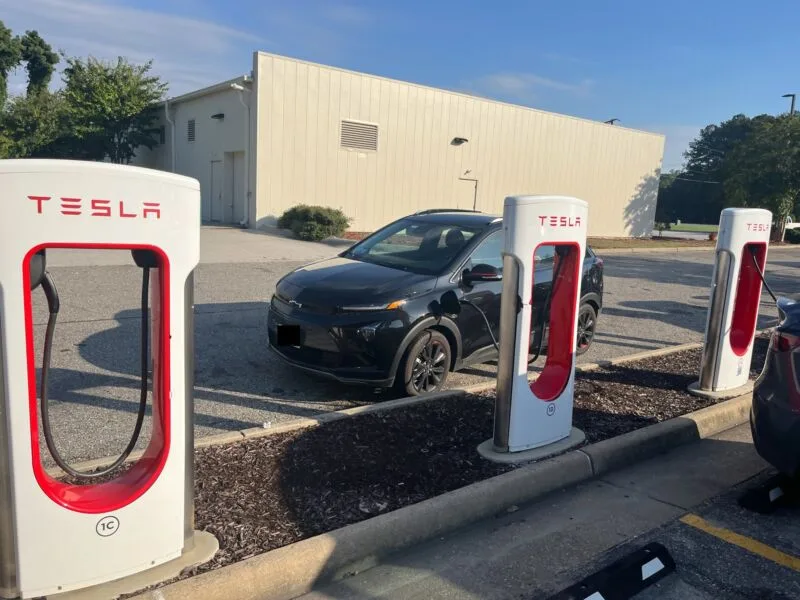reader comments
60
It should not be so exciting to eat a breakfast quesadilla in your car.
But this quesadilla was from Wawa, this Wawa hosted a Tesla Supercharger, and this car was the 2023 Chevrolet Bolt EUV, hooked up to that Supercharger through a NACS/CCS adapter. More than a year after GM’s switch to NACS was announced, and following some Tesla internal chaos that made it seem like a dead deal, Tesla unlocked access to its conveniently placed EV charging stations to General Motors cars in late September. It wasn’t every Supercharger, but it was more than 17,000 spots, many in places that were previously dark zones in any road trip plan.
I bought my car knowing that road trips would be an infrequent but real inconvenience. With Tesla's network available now, the anxiety of rolling the CCS dice in unknown lands has lessened considerably. To understand just how this feels, you must first hear about the Before Times.
-
The lineup inside an outlet mall parking garage for Electrify America spots. You have to let the Fisker owner go first, right? Kevin Purdy
-
Forced to park the most inefficient way possible at a New Jersey Electrify America, while four cars waiting in two different lines behind me burned holes into the back of my neck. Kevin Purdy
-
The side of a ChargePoint I snapped so I could report it to the company, as it was the only 1 of 4 that worked—and only after 15 minutes. Kevin Purdy
-
You own a non-Tesla EV long enough, you build up a catalog of failed chargers. Here's an EVConnect-affiliated unit in New York's Capital Region that I called about, to no avail. Kevin Purdy
Lots of apps, few guarantees
I’ve had my Bolt for a little over a year now, completing four road trips that required DC Fast Charging (DCFC). “Fast” is a misnomer with the Bolt, the slowest-charging modern EV, forcing you to plan across battery levels, nearby amenities, pets, and guesses at crowd timing. Every night before a long ride, I’m pinching, zooming, and stressing inside A Better Route Planner, PlugShare, and Google Maps reviews, asking myself if a ChargePoint in a brewery parking lot will deliver 7 or 9 kilowatts per hour.
Despite all this groundwork, I have amassed an impressive collection of fast-charging scars in a year’s time:
- Three different highway stops on Thanksgiving weekend with multi-car lines, endangering our pick-up time at dog boarding
- An Electrify America station where a single car’s terrible parking made every other car occupy two working plug spaces
- Excessive exposure to outlet malls, the EV honeypots with the most reliably working non-Tesla chargers
- A single ChargePoint level 2 charger working (after a long delay) out of four in a hotel parking lot, the only charging spot on a vacation island.
- A state-sponsored EV charging spot where two of out five plugs worked, then only one after a mid-charge failure, where a man heading to a Dave Matthews concert begged me to swap this last spot with him so his wife wouldn’t miss the band's opening song.
It almost doesn’t matter exactly why or how a non-Tesla charger refuses to work. Damaged cables or plugs, busted screens, cellular data drops, app issues, electrical faults—whatever the reason, it will never get fixed in that moment by calling the support number, and now you need a backup plan.
This is how I think Supercharger access is most useful to us, the wretched of the EV earth: a robust backup plan for those tired of the alternatives. Plugging into the country’s most established network requires a none-too-cheap adapter (or finding a rare “Magic Dock” station). You have to find a way to connect a very short cable meant for a specific driver-side-rear-end location to your port. On the Bolt, that’s the middle-front-left, just ahead of the door, possibly the worst place for these cables. You can only charge at third- and fourth-generation chargers. And you have to pay whatever Tesla decides to charge us non-members, which is usually on the costlier side (I’ve paid $0.48 and $0.53 per kilowatt-hour).
Original Article Published at Arstechnica
________________________________________________________________________________________________________________________________

